

Yeah, tell it to the community here. Literally half the comments are endorsing piracy in one way or another.


Yeah, tell it to the community here. Literally half the comments are endorsing piracy in one way or another.


While I do think this is a good idea, I don’t think it can be attributed as a factor in the accident. The captain of the Japanese Coast Guard had nearly 5 years under his belt and was likely much more familiar with ICAO phraseology than what is used in North America.


Thank you for pointing this out.
I had also looked into it in more detail, and came to the same conclusion. In the ICAO quick reference guide they provide an almost identical example:
Taxi to holding point C, runway 27, Big Jet 345
I’ve clarified this in my analysis.


The official transcript was shared in a press conference:
[ATC] JA722A Tokyo Tower. Good evening. No.1, taxi to holding point C-5.
[JA722A] Taxi to holding point C-5, JA722A No.1. Thank you.
I’ve put together a detailed write-up here.


The aforementioned Live Cam video provides evidence that JA722A entered onto runway 34R at intersection C-5 and remained stationary until the impact. As a visual reference, other aircraft DAL276 and JAL545 are seen further to the right, queueing up to intersection C-1. The moment of impact is also captured in a passenger video from on board an aircraft taxiing past C-5.
Previous discussion that JA722A would have entered at C-1 can be eliminated for the stated reasons, but also noting that this intersection is too short of the touchdown zone of runway 34R, and this video (at 1:48) appears to show the burning collision site as seen from a plane that was holding short at C-1 of 34R. Here, too it is clear that there is some distance, about 3 taxiways between the camera and the fire, confirming that the collision must have occurred near to C-5. The Approach Lighting System (ALS) provides visual reference for runway 34R. Despite its name, standard operating procedure is that ALS is used both during takeoffs and landings.
In the press conference held by the Civil Aviation Bureau of the Ministry of Land, Infrastructure, Transport and Tourism and the Japan Coast Guard, where a collision diagram was shown to reporters [2]:
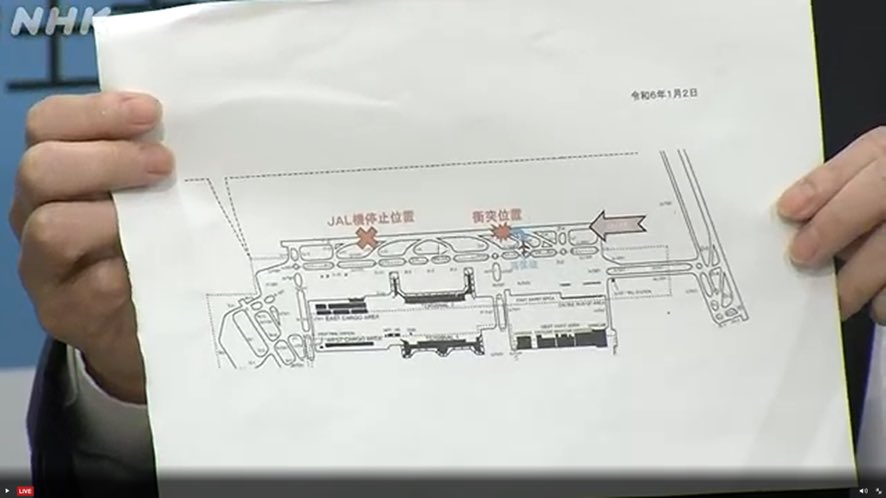
Here I’ve recreated that illustration that labels both intersections C-1 and C-5 on the updated 2022 RTJJ/HND airport chart:
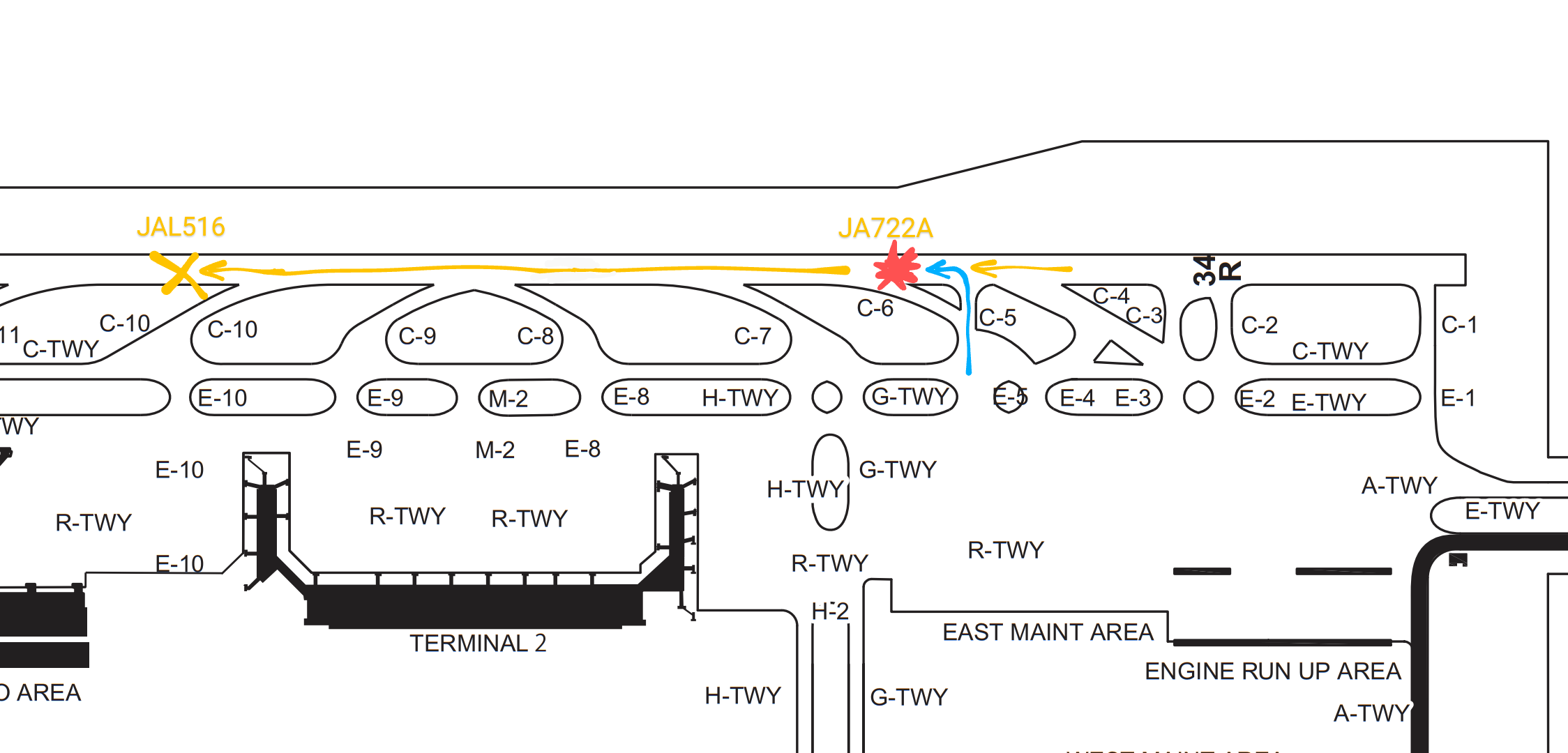
JAL516 touched down on 34R, and while flightradar24 doesn’t show any aircraft on the runway ahead of them, it should be noted that JA722A was not equipped with a modern ADS-B transponder (or its mode S was switched off):
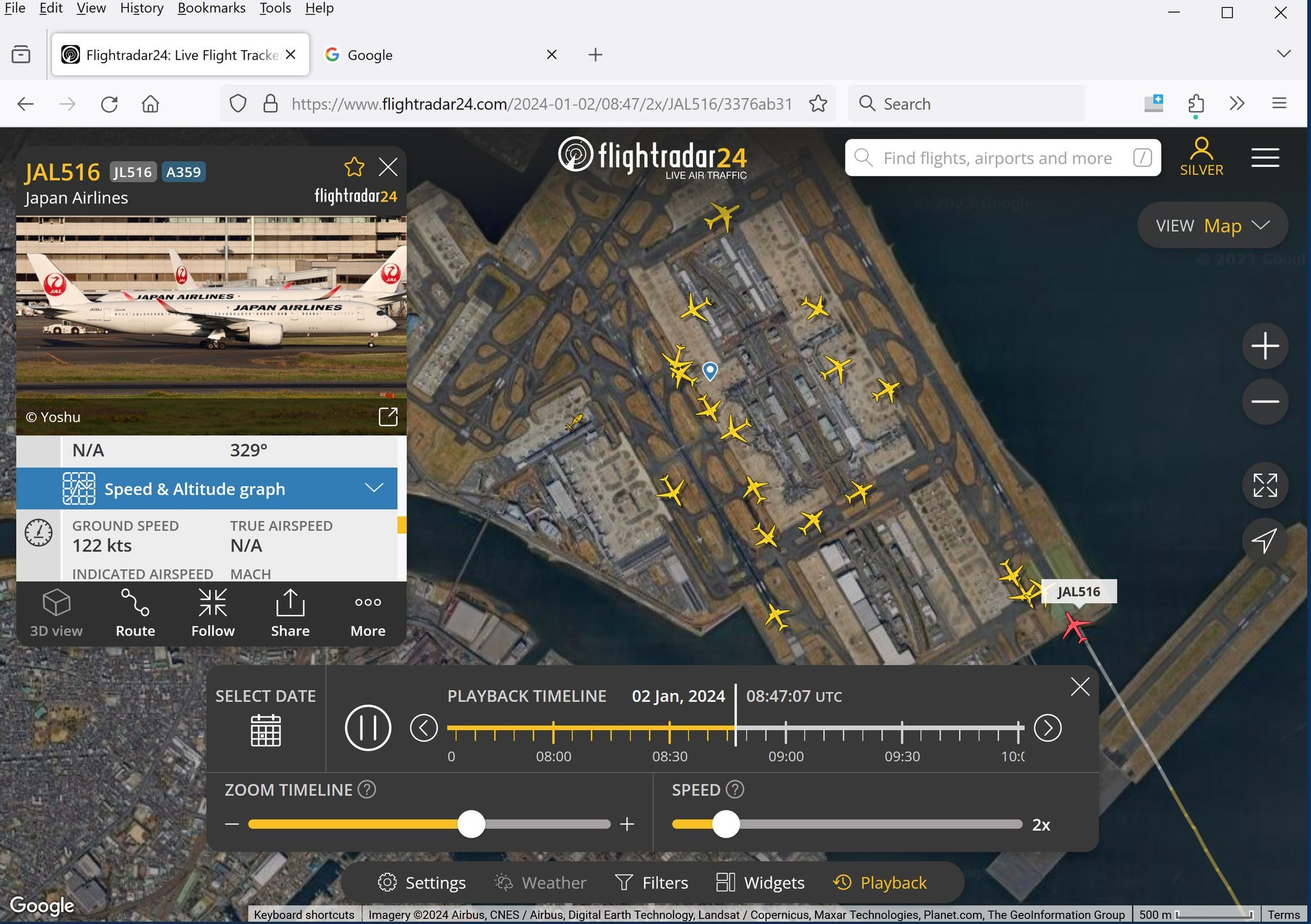
It should be noted that JA722A cannot be reliably tracked by flightradar24 and here’s an explanation why). Despite JA722A having an older model transponder, ATC should have accurately seen it on their ground radar.
By daylight, the resting positions of both aircraft are plainly visible:
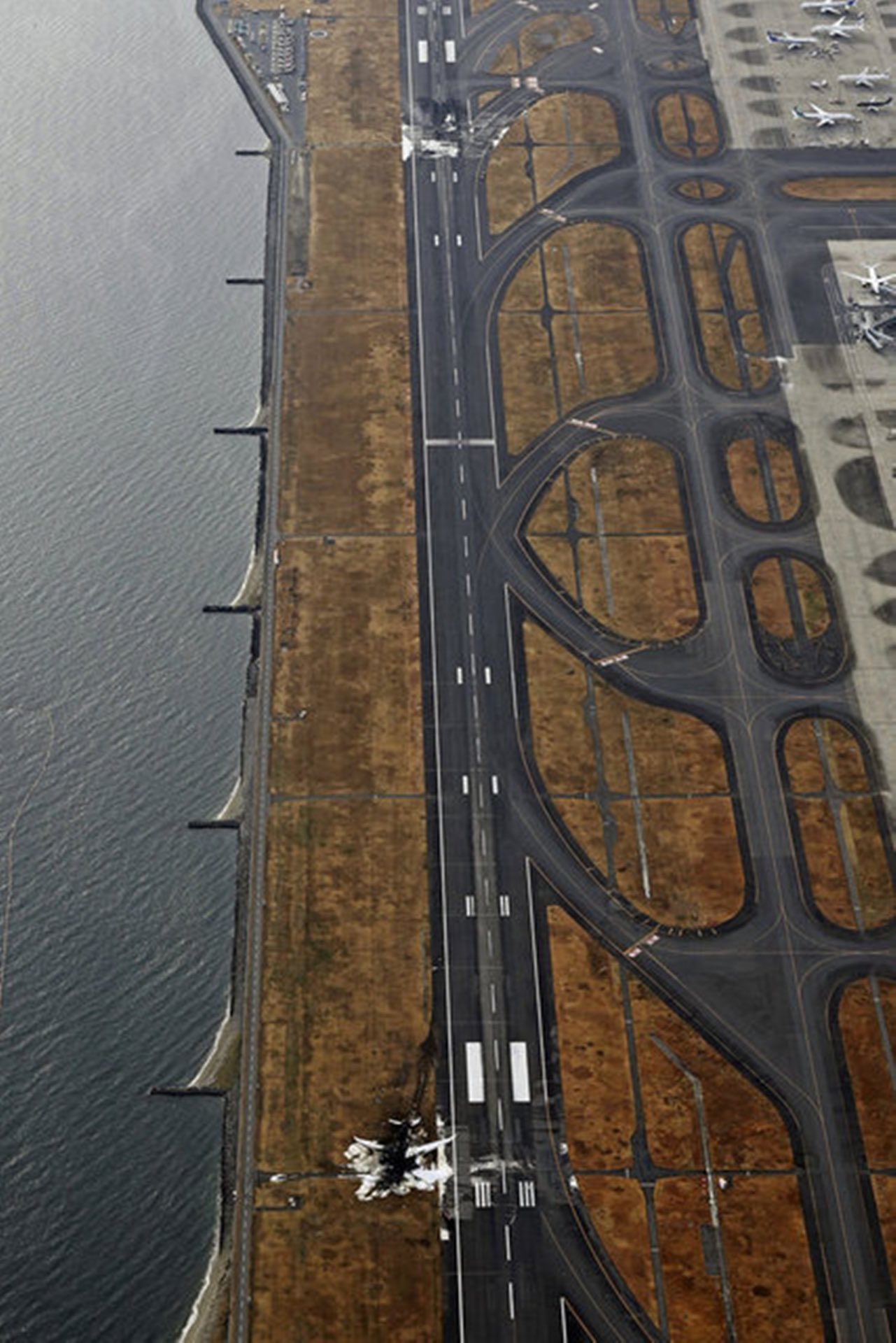
According to Japan’s transportation ministry, JA722A was instructed to “taxi to holding point C-5,” and read back that instruction. It nevertheless entered onto the runway without ATC clearance. JA722A had six minutes after the previous departure of JAL25 to maneuver onto the runway for takeoff, and it’s possible that ATC wished to prioritize the departure of delivering earthquake relief aid by shortcutting it onto the runway ahead of the queue of commercial aircraft holding ahead of C-1.
This appears to be standard ICAO phraseology for holding short of a runway at an intersection, where the guidelines provide the following example [13]:
Taxi to holding point C, runway 27, Big Jet 345
It’s possible that JA722A was under the incorrect impression that it was cleared to enter runway 34R at C-5 and hold for takeoff on the runway. The phraseology for doing so, however, is given as an example in the ICAO quick reference guide as:
Big Jet 345, Metro Tower, line up runway 27
The transcript does not include an explicit instruction from ATC to “line up.”
A further insight is regarding the Autonomous Runway Incursion Warning System. According to a NOTAM bulletin, the Stop Bar Lighting at junctions C-1 to C-14 were unserviceable since Dec 27th, as per a NOTAM bulletin. [11, 12]. This stop line is where ATC expected JA722A to stop, ahead of intersection C-5 prior to the runway:
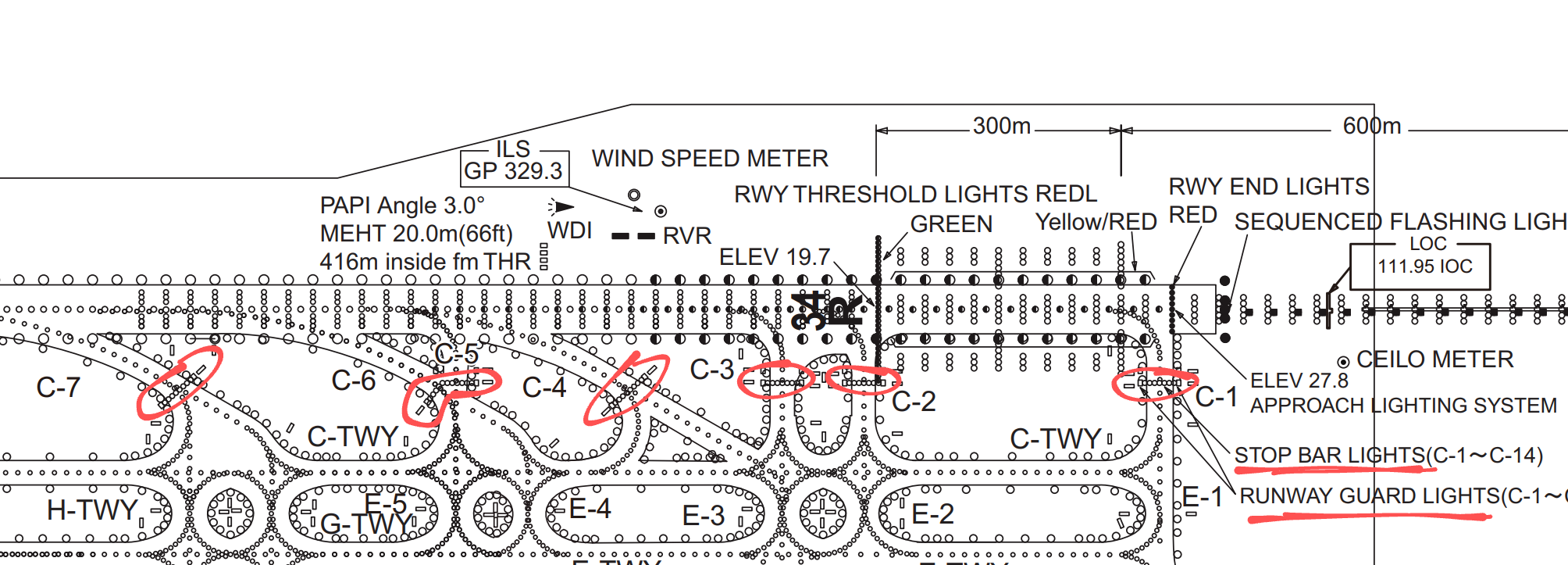
Please observe that currently no concrete evidence has been published to support any hypotheses. Therefore, remember to avoid jumping to conclusions as we do not have all the facts yet.
1. Did JA722A enter onto the runway with unambiguous ATC clearance, and if not, why did they do so anyway?
Editorial notes: JA722A did not have ATC clearance to enter the runway, and it appears that ATC used standard ICAO phrasing to instruct the aircraft to hold short of 34R ahead of intersection C-5. [13]
2. Why did ATC radar not trigger an automated collision warning through runway incursion monitoring for JAL516 if JA722A was on the same runway?
3. Why did JA722A not react to and communicate regarding a stop signal from the Autonomous Runway Incursion Warning System (ARIWS)?
Editorial notes: Stop Bar Lighting at junctions C-1 to C-14 were unserviceable since Dec 27th, as per a NOTAM bulletin. [11, 12]
4. Did JA722A have its strobe lights illuminated?
5. Why did neither the tower nor JAL516 see JA722A on 34R?
6. Why didn’t a collision avoidance system activate on board JAL516?
Editorial notes: TCAS is inhibited below 900 feet above ground level. [9]
The official inquiry will likely focus on the ground radar, ATC transcripts and CVR recordings.
As a reminder, please do not to jump to conclusions as we do not have all the facts yet.


They deployed three slides: the starboard rear exit could not be used because the number 2 engine was not able to shut down and was spraying sparks.


Last updated Jan 2, 11:20 UTC; this post is superseded here
JAL flight 516 (registration JA13XJ) Airbus A350-900 from Sapporo to Tokyo’s Haneda Airport collided while landing with a coast guard aircraft JA722A De Havilland Canada DHC-8-315Q MPA “Dash-8” that belonged to Haneda Air Base, which was awaiting departure to Niigata with aid following the New Year’s Day Earthquake.
All 367 passengers and 12 crew members escaped the passenger plane, while five people on the coast guard plane were still unaccounted for, NHK reported.
The pilot of the coast guard aircraft had evacuated and contacted officials.
CNN reports that 17 passengers on board JAL516 were injured.
A later press statement from Japan Airlines SVP Noriyuki Aoki clarified that “only four” passengers went to hospital for “feeling unwell,” of which two for smoke inhalation, while the pilots are now being interviewed about the final moments of the flight. Eight children were among the 367 passengers.
Regarding JA722A, CNN reports:
Five crew members died on the second aircraft, a De Havilland Canada DHC-8, according to Japan’s transport minister, Tetsuo Saito. Public broadcaster NHK said the plane’s captain was in a critical condition.
Airbus has also issued a statement that a team of Airbus investigators are joining the French BEA and Japanese JTSB.


Last edited Jan 4, 12:25 UTC
Japan Airlines flight 516 (JAL516, registration JA13XJ) Airbus A350-900 from Sapporo to Tokyo’s Haneda Airport collided while landing with a coast guard aircraft JA722A De Havilland Canada DHC-8-315Q MPA “Dash-8” that belonged to Haneda Air Base, which was awaiting departure to Niigata with aid following the New Year’s Day Earthquake.
All 367 passengers (including 8 children) and 12 crew members safely evacuated JAL516 after it stopped in the grass adjacent runway 34R. [1] Japan Airlines SVP Noriyuki Aoki clarified in a press statement that of the 14 injuries, “only four” passengers went to hospital for “feeling unwell,” of which two for smoke inhalation. [2] The aircraft’s nose gear collapsed and engines and wings were engulfed in flames immediately following the collision.
Of the six crew members on board JA722A, 5 crew members died in the collision or resulting fire, according to Japan’s transport minister Tetsuo Saito. Public broadcaster NHK said the plane’s captain was in a critical condition. [1]
The immediate seconds following the collision show both the Airbus (left) and Dash-8 (right) in flames:
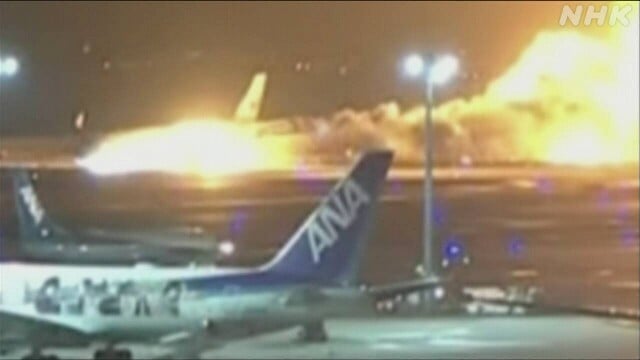
These are the aircraft involved:
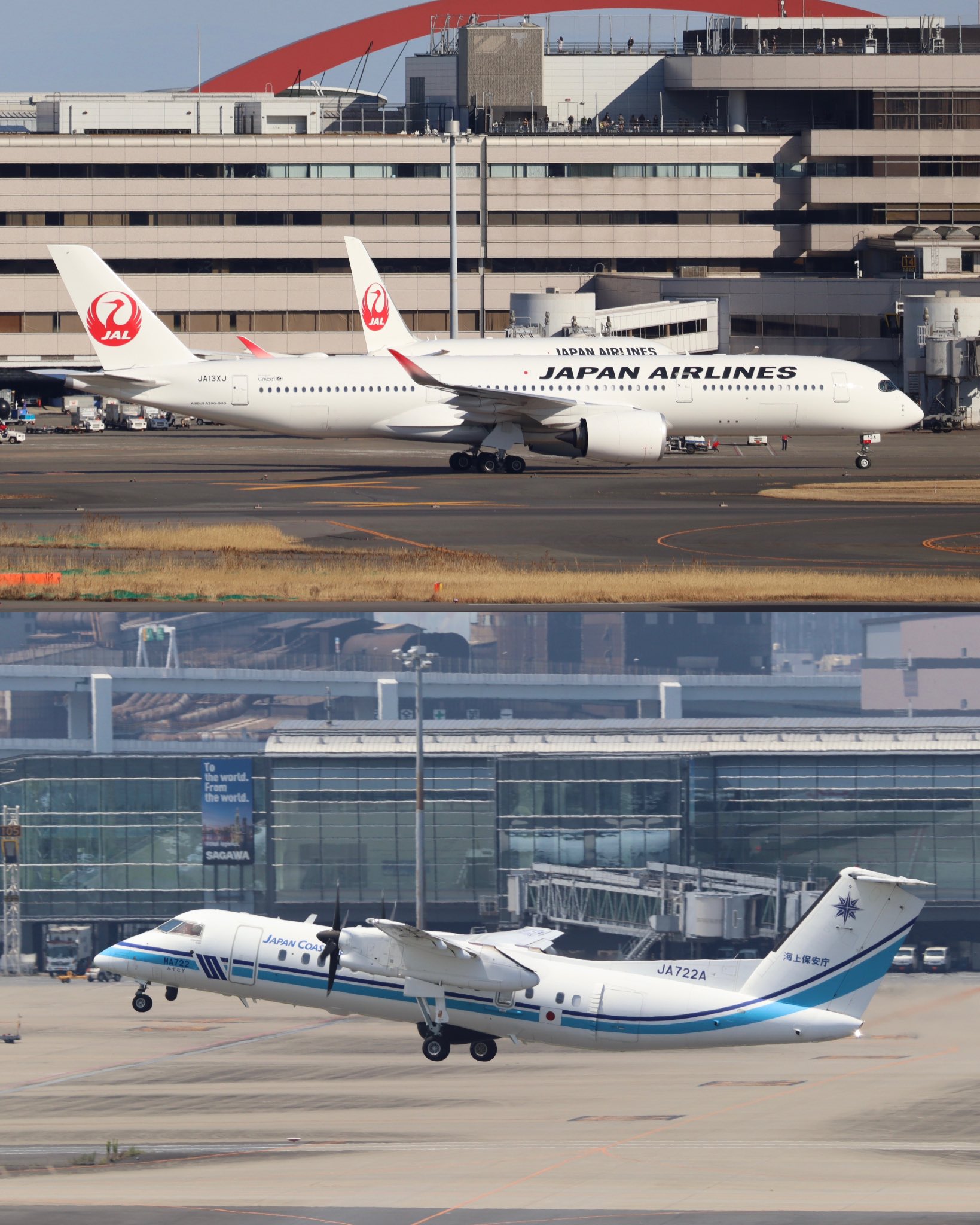
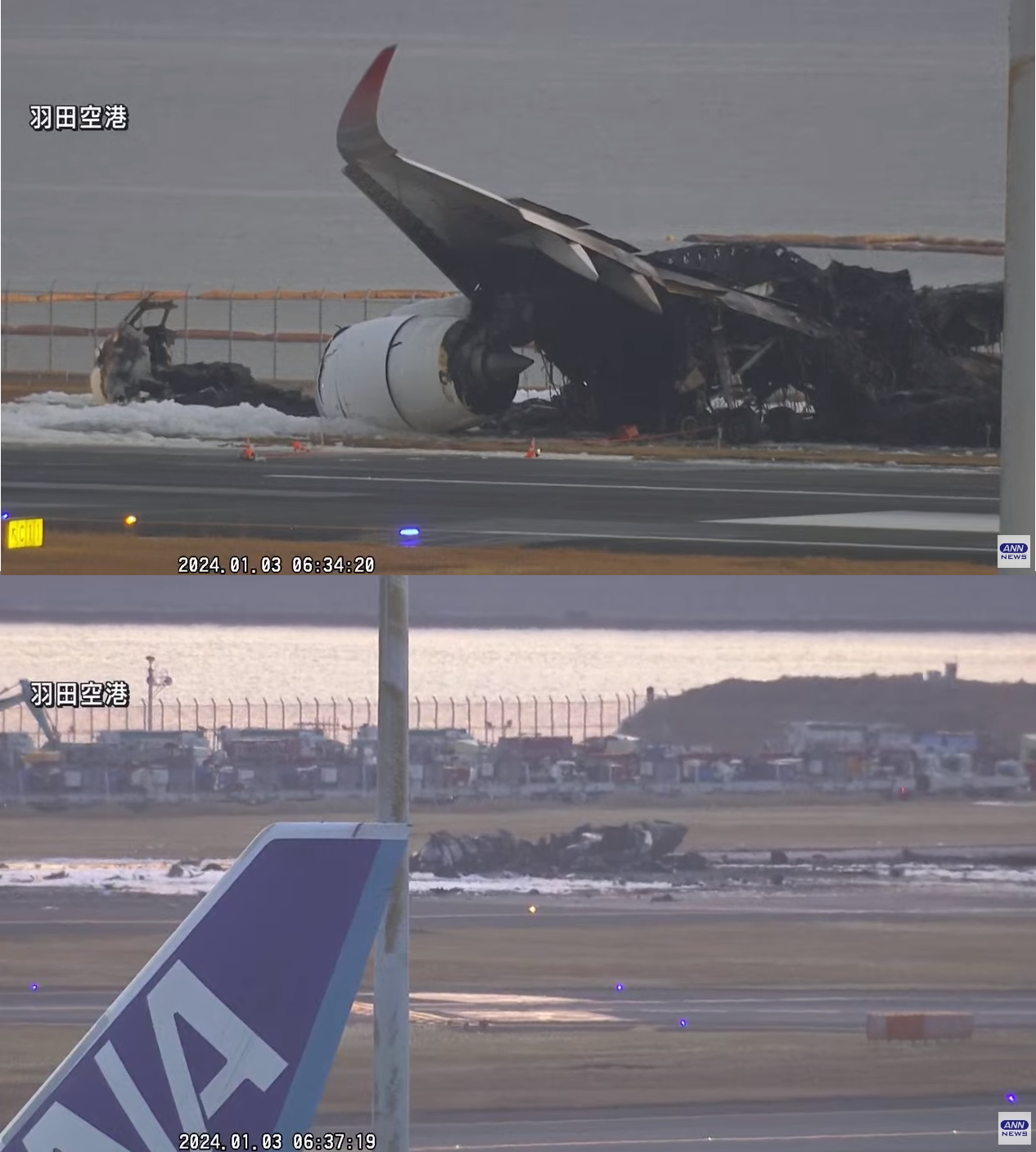
Airbus has issued a statement that a team of Airbus investigators are joining the French BEA, British AAIB and Japanese JTSB. [3]
Japan’s Ministry of Transport said on Jan 3rd that JA722A had received instructions to “proceed to a holding point on a taxiway to the runway,” [4] noting that the coast guard captain by his own testimony however understood this instruction as takeoff clearance [5], subsequently lining up on runway 34R and setting the stage for the collision. The JTSB is investigating the occurrence.
Tokyo’s Metropolitan Police reported they have opened an investigation for professional negligence into the accident.
The JTSB has recovered the voice recorder from the coast guard aircraft. [3]
Minutes after evacuation of JAL516, which completed 18 minutes after touching down [10], the cabin flashed over and the aircraft was reduced to just the engines, wings and parts of the tailplane and nose cone. Daybreak revealed the devastation of the inferno, despite the extinguishing efforts of more than 100 fire engines [2]:
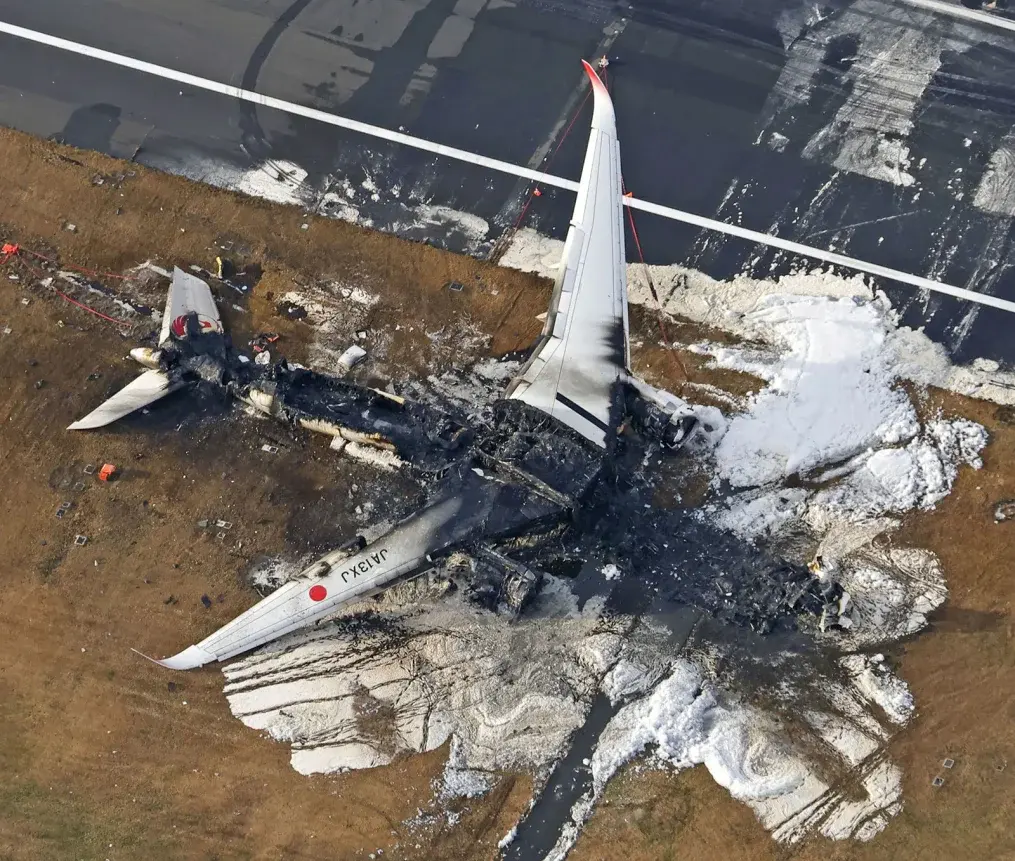
A compounding factor is that the right hand number 2 engine was unable to be shut down and continued to run during the evacuation of the passengers [6], and a video recording shows it spraying sparks that inhibited the use of the rear starboard escape slide.
Videos and photos suggest that of the eight exits, only three slides were used in the evacuation (rear port side and both front exits):
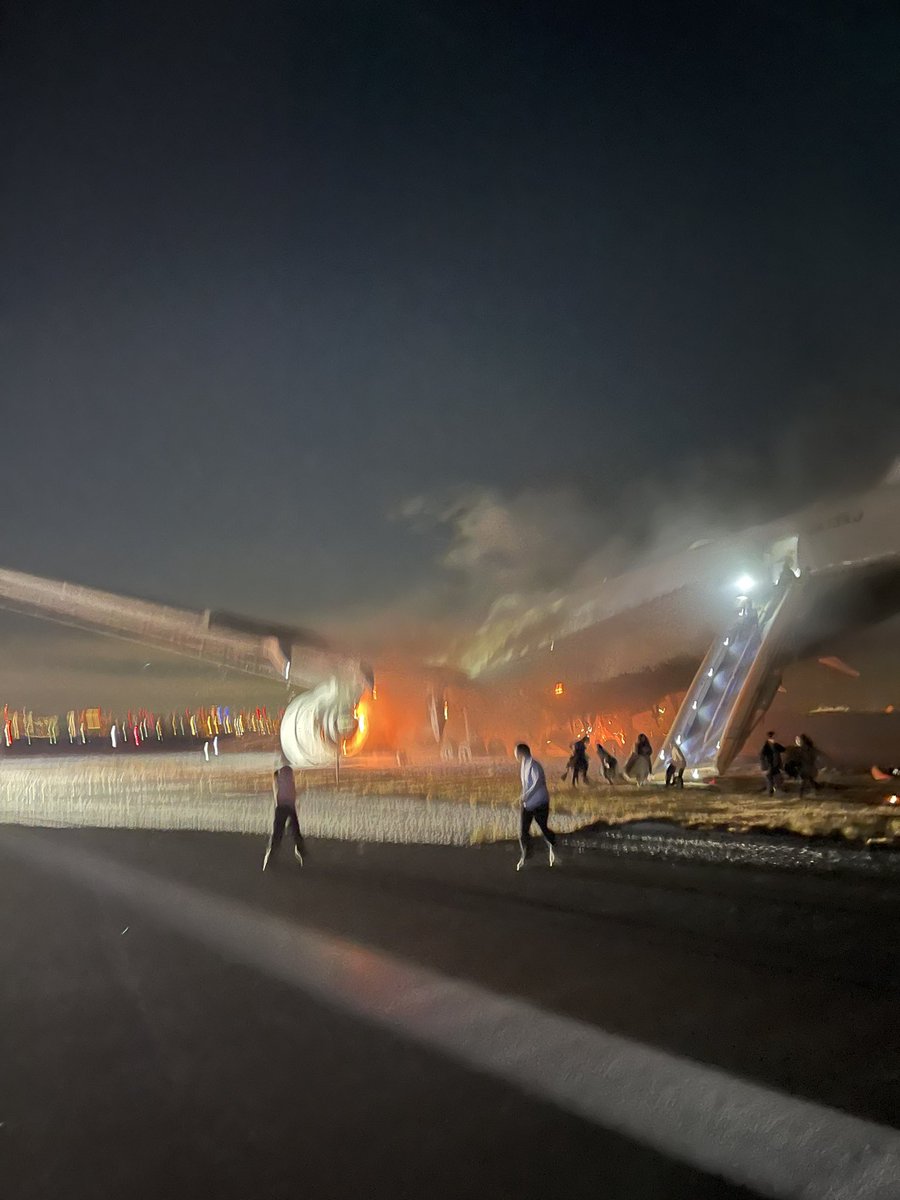
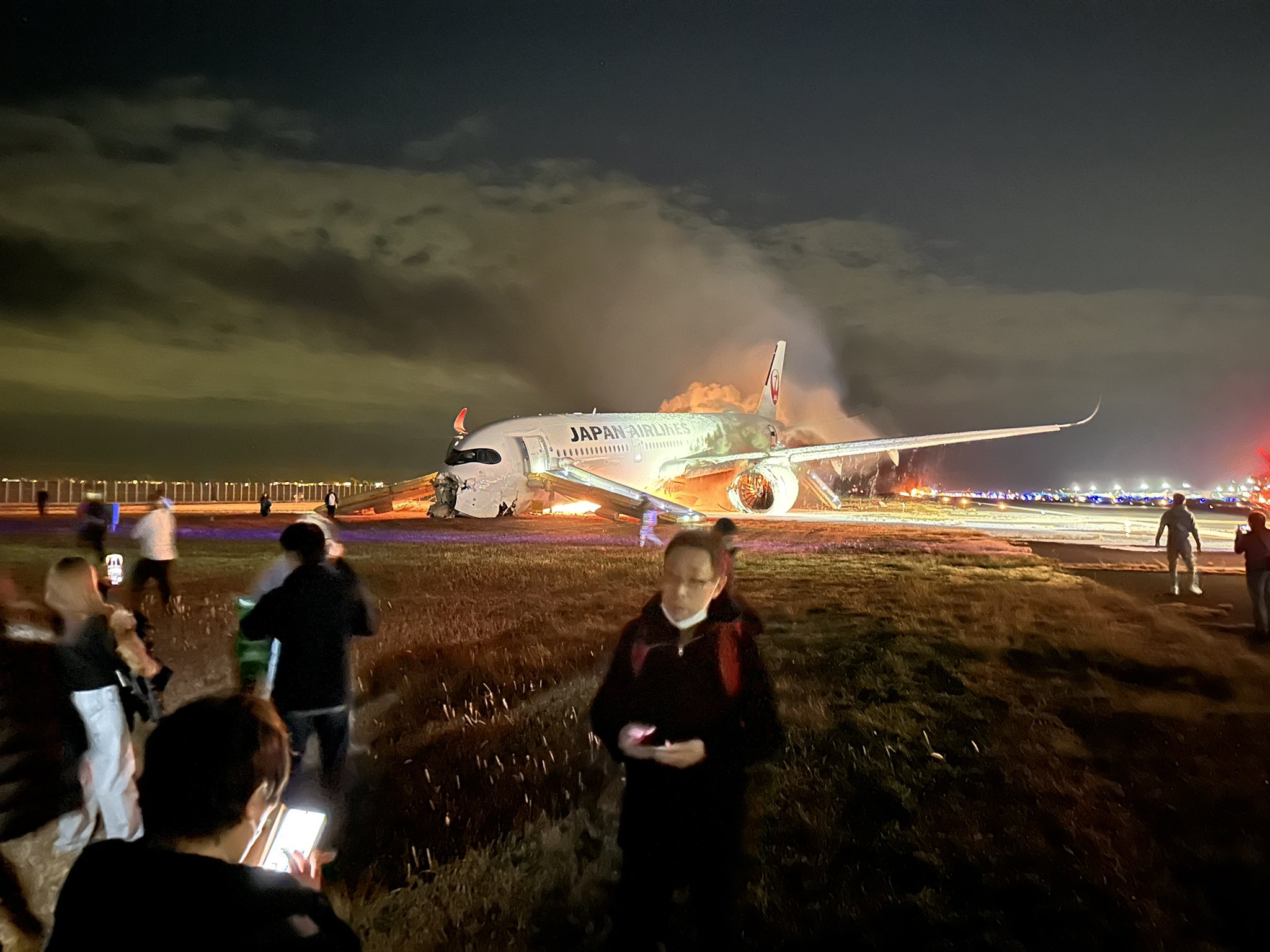
Smoke was present in the cabin during evacuation (longer video) and one passenger stated in an interview that it smelled of “burning chemicals.” [2]
This marks the first hull loss of an A350. JAL516 was newly delivered to Japan Airlines in November 2021.
The Dash-8 involved, JA722A, also called under its alternative registration, MA722 “Mizunagi,” and was piloted by captain Genki Miyamoto (39), who has been the captain of the same type of aircraft since February 2017 with a total of 4 years, 11 months of experience as a captain and 3,641 fight hours. [14] Miyamoto pulled himself from the wreckage with severe burns and radioed his base, saying, “The aircraft exploded on the runway. I escaped. The [condition of the] other crew members is unknown.” [7]
The victims were Nobuyuki Tahara (co-pilot, 41); Yoshiki Ishida (radio operator, 27); Wataru Tatewaki (radar operator, 39); and Makoto Uno (mechanic, 47), and Shigeaki Kato (56), the Coast Guard said in a statement. [14]
Footage from the Tokyo International Airport HND Live Cam clearly shows JA722A enter onto the runway where the collision occurred at intersection C-5 roughly 50 seconds before the accident. The Dash-8’s landing light appears to be aligned with the runway in preparation for takeoff. The Airbus had touched down on all wheels shortly prior to impact.
This is further supported by evidence of a direct impact from behind. Nose cone damage on the A350 suggest a direct impact with the Dash-8’s aft fuselage or tail section, as evidenced by a user on Twitter by comparing schematics of both aircraft to scale:

Furthermore, the crushed remains of the Dash-8 appears to show relatively less damage to the front of the aircraft:
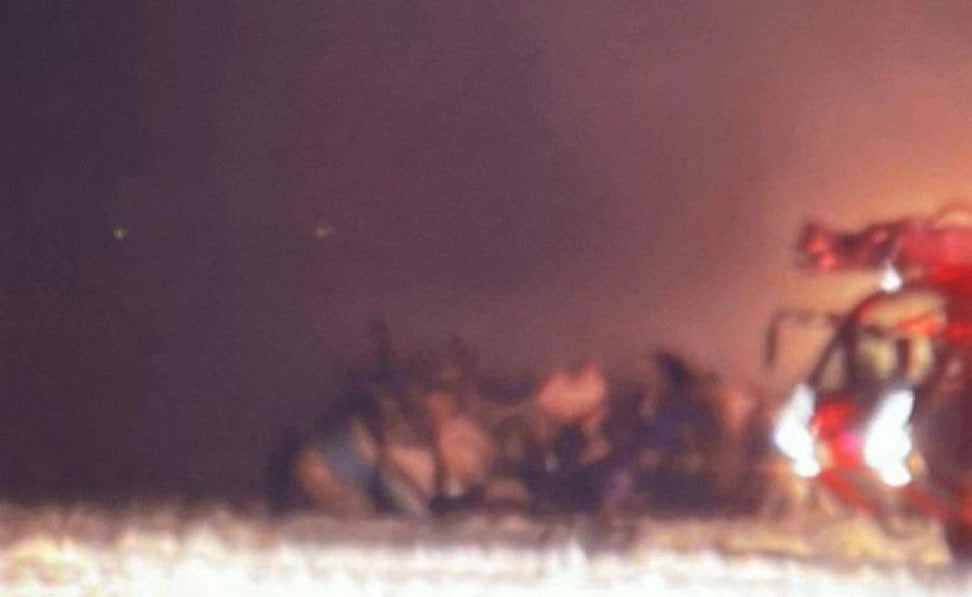
The user goes on to point out the engine cowling damage on both the number 1 and 2 engines, suggesting the Dash-8’s wingtips were struck straight or nearly straight on from behind:
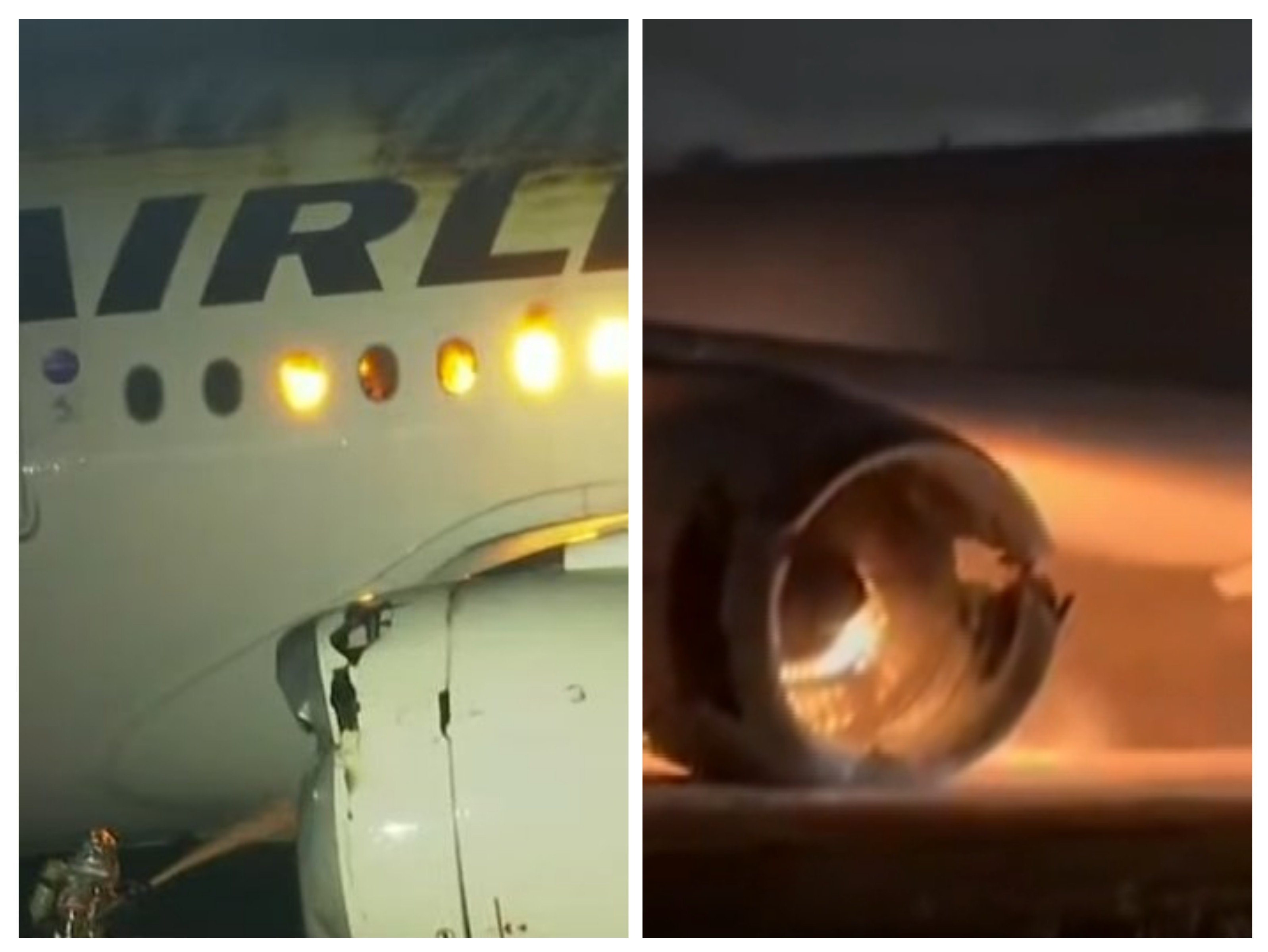
Japan Airlines said its crew had been cleared to land by air traffic control before the collision. Audio from LiveATC.net (captured in this video) appears to detail the crew reading back a clearance order for runway 34, saying “cleared to land 34 right.” [1]
“According to interviews with the operating crew, they acknowledged and repeated the landing permission from air traffic control, and then proceeded with the approach and landing procedures,” Japan Airlines said. [1]
The ATC communication to JA722A is difficult to understand, but the transcript released to NHK records it as follows [8]:
[ATC] JA722A Tokyo Tower. Good evening. No.1, taxi to holding point C-5.
[JA722A] Taxi to holding point C-5, JA722A No.1. Thank you.
From this point to the collision, ATC was not heard granting permission for JA722A to enter the runway.
While the LiveATC.net recording does not include JA722A reading back the aforementioned ATC instruction, Japan’s transport ministry stated on Jan 3 that based on the transcript, air traffic control instructed the coast guard plane to proceed to a holding point on a taxiway to the runway 10 seconds after clearing JAL516 to land on 34R at 5:45 p.m., to which the coast guard plane repeated the instruction. [9]
Editorial notes: (1) There had previously much debate about the transcript, as some listeners heard “C-1” or “C-2” instead of “C-5.” (2) The phrasing of this communication is further discussed in the section “Speculation” below.
In response to a question about whether the JA722A had been given permission to enter the runway, the head of the Civil Aviation Bureau of the Ministry of Land, Infrastructure, Transport and Tourism said at a press conference on Jan 2, “We are currently investigating and cannot comment on that at this stage.”


Oh, completely agreed; generally I avoid such things in much the same way.


Another reason why piracy is justified. You’re pandering to corporations and lining the wallets of rich douches like Kotick if you’re paying for video games. ^♪


Of course! EVs are more efficient again, however, in part because they can replace the space and weight of the engine and fuel tank with batteries.


For what it’s worth, I never argued that shoplifting isn’t stealing. I only pointed out the absurdity of the argument that piracy is justified.
Feel free to educate me on the basic concepts I’m failing to understand.


How exactly are you going to decide which locations and which kind of groups are or aren’t allowed? I understand your frustration—having lived in Amsterdam for some time, the tourism really got under my skin—but realistically I think the better approach is to prohibit specific things that are causing annoyances, like using loudspeakers (or, in the case of Amsterdam, beer bikes). Another way to deter tourism is by increasing tourist taxes.


Since this community has already established that piracy* is justified, and we need our SSDs to store all our morally rationalized but illicitly obtained copies of content we enjoy but don’t want to spend money on, how do we now proceed? Obviously we won’t spend money, it’s the entire reason we’re pirating in the first place. This leaves us with only one option: we’ll have to be modern-day Robin Hoods and shoplift these SSDs, because fuck corporate greed.


Plus carrying around the weight of both the batteries and the ICE with its tank of fuel.


I think a compounding factor is that the lifespan of phones has also increased. Phone manufacturers are no longer selling a new model to the same user each year.


It’s odd that we should need to spell out that different devices are designed for different kinds of users with different use cases.


The mental gymnastics people use to excuse themselves of their entitlement continues to amaze me.
JA722A was reportedly piloted by captain Genki Miyamoto, who was 39. He had been the captain of the same type of aircraft since February 2017 with a total of 4 years, 11 months of experience as a captain and 3,641 fight hours. [Source]